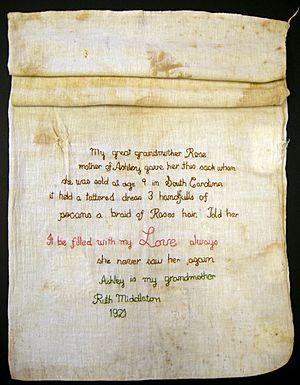Ashley's Sack facts for kids
Quick facts for kids Ashley's Sack |
|
|---|---|

Courtesy Middleton Place Foundation
|
|
| Material | Cotton, thread |
| Size | 29+11⁄16 × 15+3⁄4 inches 75 × 40 cm |
| Created | 1850s; embroidering added 1921 |
| Discovered | Nashville, Tennessee |
| Present location | Washington D.C. |
Ashley's Sack is a special cloth bag from the mid-1800s. It has an embroidered message that tells a sad but important story. The story is about a nine-year-old girl named Ashley who was separated from her mother, Rose, because of slavery. Rose gave Ashley this sack as a parting gift.
Inside the sack, Rose put a dress, a braid of her hair, some pecans, and a message: "my love always." This gift was likely passed down through the family. Ashley's granddaughter, Ruth (Jones) Middleton, later embroidered their story onto the sack in 1921.
Today, Ashley's Sack is on display at the National Museum of African American History and Culture in Washington D.C. It is on loan from Middleton Place in Dorchester County, South Carolina, a historic plantation site. Experts say the sack is a very rare item from a time when human slavery was legal in the United States. It helps us understand the pain and strength of people who lived through slavery.
Contents
The Sack's Journey
How the Sack Was Found
Ashley's Sack was bought for just $20 at a flea market in Nashville, Tennessee in the early 2000s. The woman who bought it was shocked by the embroidered story. It told of a mother and daughter being separated due to slavery. She searched online for "slavery" and "Middleton" and then gave the sack to Middleton Place.
Learning Its History

From 2009 to 2013, the sack was displayed at Middleton Place. It deeply moved many visitors. At first, no one knew who Rose, Ashley, or Ruth were.
Then, a professor named Mark Auslander, who studies cultures and museums, began to research the sack's history. He used old records like census reports, wills, and newspaper announcements. His research helped him find out more about Ashley, her mother Rose, and Ruth, who did the needlework.
Professor Auslander's research suggests that Ashley and Rose were owned by a rich merchant and planter named Robert Martin. He lived in Charleston, South Carolina. After Martin died in 1852, Ashley was likely sold away from her mother. This was done to raise money for his family.
Ruth's Life Story
Professor Auslander also found out more about Ruth. He believes Ruth Middleton was born Ruth Jones around 1903 in Columbia, South Carolina. Her parents worked as servants at the University of South Carolina.
Ruth later moved to Philadelphia, Pennsylvania. She married Arthur Middleton, who was also from South Carolina. Ruth had a daughter named Dorothy Helen in 1919. In 1921, when Ruth embroidered Ashley's Sack, she was likely a single mother.
Ruth worked in wealthy homes in Philadelphia. By 1928, she was well-known in Philadelphia's African-American high society. She was often mentioned in the "Smart Set" and "High Society" pages of The Philadelphia Tribune, a major African-American newspaper. Ruth hosted parties and wore elegant clothes. Her daughter, Dorothy Helen, was also known for her fashion sense.
Ruth died in January 1942 from tuberculosis. Dorothy Helen died in 1988.
The Embroidered Message
The powerful message embroidered on the sack by Ruth Middleton in 1921 reads:
My great grandmother Rose
mother of Ashley gave her this sack when
she was sold at age 9 in South Carolina
it held a tattered dress 3 handfulls of
pecans a braid of Roses hair. Told her
It be filled with my Love always
she never saw her again
Ashley is my grandmother
Important Dates
Professor Mark Auslander's research helped create this timeline of events:
- 1843/44: Ashley is born.
- 1853: Ashley, at age 9, is sold away from her mother Rose.
- 1865: The Civil War ends, and slavery is abolished.
- 1880: Ashley's daughter, Rosa Clifton, is born.
- 1903: Ruth Jones (Ashley's granddaughter) is born in Columbia, South Carolina.
- 1919: Dorothy Helen "Dot" Middleton, Ruth's daughter, is born.
- 1921: Ruth Middleton, at age 18, embroiders her grandmother Ashley's sack.
- 1942: Ruth dies at age 39.
- 1988: Dorothy Helen dies at age 69.
- 2007: Ashley's Sack is bought at a flea market and given to Middleton Place Foundation.
- 2016: Ashley's Sack is displayed at the Smithsonian National Museum of African American History and Culture in Washington, D.C.
Why Ashley's Sack Matters
The sack is a powerful reminder of the pain and strength of families during slavery. It shows how people tried to keep their family memories alive, even when they were forced apart.
Mary Elliot, a museum specialist at the Smithsonian, calls the sack an "emotional object." She says, "This piece is very important to telling that human story." It helps us connect with the past and understand the experiences of enslaved people.

